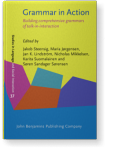Chapter 9
Second-person singular imperatives in Finnish everyday
conversations
Multifunctionality and routinization of grammatical
formats
The chapter discusses different ways in which
second-person singular imperatives are used in Finnish conversations
and how this multifunctionality should be described in a grammar of
Finnish talk-in-interaction. In traditional grammar writing, the
description of imperatives has focused on their use in directive
actions. The chapter shows that in spoken interaction, second-person
singular imperatives have a wider range of functions: they can also
be used in actions that are not primarily directive, e.g.,
storytellings, assessments, news deliveries, and informings. In such
use, they function as sedimented formulae with fixed local tasks and
recurrent collocative elements. The chapter suggests that
formulaicity and routinization of grammatical formats play an
important role in everyday language use, which should be reflected
in grammar writing.
Article outline
- 1.Introduction
- 2.Background
- 3.Distribution of second-person singular imperative forms in the
data
- 4.Analysis: Use of second-person singular imperative forms
- 4.1Kat(s)o
‘look.2sg.imp’
- 4.2Kuule
‘hear.2sg.imp’
- 4.3Älä
‘neg.2sg.imp’
- 4.4A(j)attele
‘think.2sg.imp’
- 4.5O(d)ota
‘wait.2sg.imp’
- 4.6Sano ‘say.2sg.imp’
- 4.7Arvaa
‘guess.2sg.imp’
- 4.8Summary
- 5.Discussion: Second-person singular imperatives
in an
interactional grammar
- 6.Conclusions
-
Acknowledgements
-
Notes
-
References
This content is being prepared for publication; it may be subject to changes.
